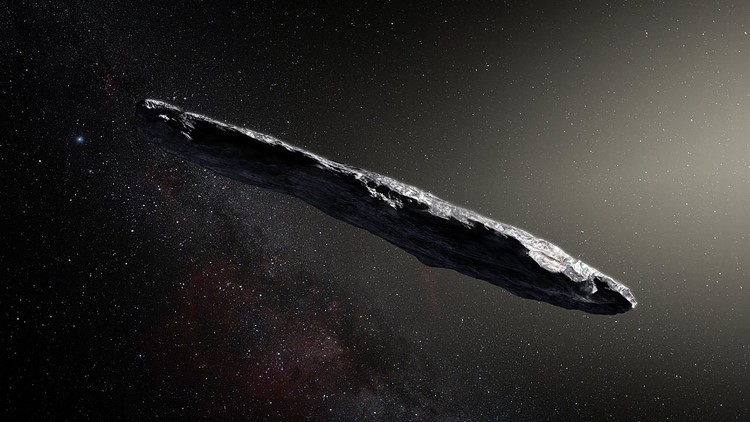On October 19, 2017, the Pan-STARRS 1 telescope in Hawaii spotted something strange zooming through our solar system. It turned out to be a visitor from beyond our solar system, and several of its odd features still confound astronomers.
It was the first observed object from outside our solar system, according to a study published in the journal Nature — and, as the researchers call it, an “oddball.”
“What we found was a rapidly rotating object, at least the size of a football field, that changed in brightness quite dramatically,” lead study author Karen Meech of the University of Hawaii’s Institute of Astronomy and leader of the research team said in a statement.
The long and rocky cigar-shaped object has a burnt dark-reddish hue due to millions of years of radiation from cosmic rays. This hue is similar to that of objects found in the Kuiper Belt, in the outer part of our solar system, but its orbit and shape firmly place it in the category of interstellar origin. It most likely has a high metal content and spins on its own axis every 7.3 hours.
But the shape, 10 times as long as it is wide, has never been seen before. This complex and convoluted shape means the object varies incredibly in brightness.
At first, astronomers thought the rapidly moving faint light was a comet or an asteroid that had originated in our solar system. But based on its orbit, the astronomers realized that the object came from interstellar space.
They acted fast, and multiple telescopes focused on the object for three nights to determine what it was before it moved out of sight at 85,700 miles per hour. They dubbed it ‘Oumuamua. The Hawaiian name, partly coming because of the location of the telescope that discovered it, loosely means “a messenger that reaches out from the distant past.”
Because the object was so difficult to classify, showing characteristics of both an asteroid and a comet, and astronomers had so little time to observe it, other theories emerged.
Last year, a Harvard paper alleged that it was an alien spacecraft sent to investigate Earth.
The theory is based on the object’s “excess acceleration,” or its unexpected boost in speed as it traveled through and ultimately out of our solar system in January.
“Considering an artificial origin, one possibility is that ‘Oumuamua is a light sail, floating in interstellar space as a debris from an advanced technological equipment,” wrote the paper’s authors, suggesting that the object could be propelled by solar radiation.
The paper was written by Abraham Loeb, professor and chair of astronomy, and Shmuel Bialy, a postdoctoral scholar, at the Harvard Smithsonian Center for Astrophysics. Loeb has published four books and more than 700 papers on topics like black holes, the future of the universe, the search for extraterrestrial life and the first stars.
But a new analysis of all the existing data about ‘Oumuamua was published Monday in the journal Nature Astronomy. The research suggests that the interstellar object is natural in origin and not an alien spacecraft. CNN has reached out to Loeb and Bialy for comment.
“We have never seen anything like ‘Oumuamua in our solar system. It’s really a mystery still,” said Matthew Knight, associate research scientist at the University of Maryland’s Department of Astronomy. “But our preference is to stick with analogs we know, unless or until we find something unique. The alien spacecraft hypothesis is a fun idea, but our analysis suggests there is a whole host of natural phenomena that could explain it.”
‘Oumuamua spins like a bottle, appearing to accelerate on its path although there is no visible evidence of shedding gas.
“The motion of ‘Oumuamua didn’t simply follow gravity along a parabolic orbit as we would expect from an asteroid,” Knight said. “But visually, it hasn’t ever displayed any of the cometlike characteristics we’d expect. There is no discernable coma–the cloud of ice, dust and gas that surrounds active comets–nor a dust tail or gas jets.”
The research team considered the different ways ‘Oumuamua could have ended up in our solar system and where it might have originated. It’s possible that the object was in a system with a gas giant planet orbiting a star and the orbit could have ejected ‘Oumuamua. This is based on the idea that Jupiter created the Oort cloud on the edge of our solar system, a shell where comets are born on the outskirts of our solar system.
Objects in the Oort cloud could very well escape the gravity of our sun to travel through other solar systems.
“We tend to assume that the physical processes we observe here, close to home, are universal,” Knight said. “And we haven’t yet seen anything like ‘Oumuamua in our solar system. This thing is weird and admittedly hard to explain, but that doesn’t exclude other natural phenomena that could explain it.”
Explanations behind the shape, rotation and point of origin remain. But astronomers may have a better chance to study objects like this in the future when the Large Synoptic Survey Telescope comes online in 2022. The researchers believe ‘Oumuamua is only the first of many interstellar objects that will pass through our solar system in the future.
“In the next 10 years, we expect to begin seeing more objects like ‘Oumuamua. The LSST will be leaps and bounds beyond any other survey we have in terms of capability to find small interstellar visitors,” Knight said. “We may start seeing a new object every year. That’s when we’ll start to know whether ‘Oumuamua is weird, or common. If we find 10-20 of these things and ‘Oumuamua still looks unusual, we’ll have to reexamine our explanations.”



